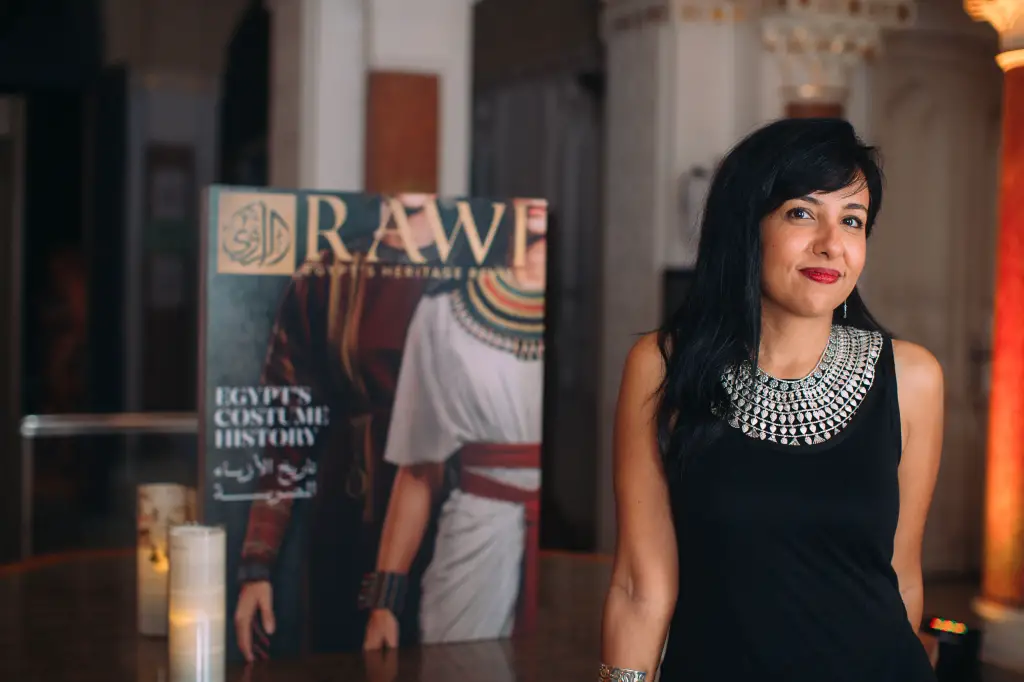February 5, 2022
By: Kenzy Hesham

In 2010, Yasmine El Dorghamy’s lifelong passion for history and heritage inspired her to create RAWI Publishing for Egyptian History, Heritage & Art; a publication that would spread knowledge and connect the world of academic historians with a non-specialised public that rarely knows of their exciting work. It would be lavishly printed, visually attractive and published in both English and Arabic.
Every year, the team at Rawi selects a new topic and works on compiling a timeline of its history in order to produce a publication that would give the reader a complete overview of the topic, written by some of the world’s foremost authorities on the subject.
In 2017 Rawi produced its first encyclopaedic format thematic edition which was on Egyptian modern art. This edition was followed by another on the history of the Egyptian cinema industry, which was followed by the very popular edition of 2019 on the history of food.
This year, Rawi produced a massive volume on the history of costume in Egypt, showcasing what Egyptians have been wearing over their entire 7000-year history. This is the first publication to compile a complete timeline of Egyptian dress from ancient Egypt to the 20th century, tracing continuity and change across the different eras of Egypt’s rich and diverse history.
Fascinated by Rawi we longed to delve deeper into the inspiration and the process behind it. On our quest for answers, we decided to interview Yasmine El Dorghamy (founder of Rawi).

WoE: What was your inspiration behind publishing Rawi?
YD: “Growing up abroad in different countries, I always felt like I needed to know more about Ancient Egypt and our history than others to properly represent my country. The more I researched and read, the more I realized that there was a lack of books covering the complete history of a topic, so I decided to fill the gap by publishing Rawi.”
WoE: What were the characteristics you believed you needed to incorporate in order to make Rawi interesting to the average person?
YD: “It needed to be visual: lush, full of vibrant colours and photographs in order to captivate the reader. The tricky part is the language used. Most indicators suggest that in order to attract people you need to use very simple and straight to the point wording; however, I’ve learned that people crave well-researched and deep articles. As I always say to the contributing specialists, write this article as if you were writing it for your dentist: an intelligent and well-educated person but has no knowledge of the topic you are discussing.”
WoE: It takes a year of hard work and dedication to get an issue published. Walk me through the process.
YD: “We have a core team made up of 4 to 5 people, who carry out countless hours of research, read academic papers, verify the validity of the information and find field specialists. For example, while working on our History of Costume in Egypt issue, we asked for help from textile archaeologists. To fund the publication of the issues, we receive support from cultural entities, companies and individuals.”

WoE: Rawi celebrated its 11th anniversary last year. What are your plans to take it one step further?
YD: “Survival in itself is a big thing as we are a non-profit organization. Nevertheless, we are aiming to exploit online visuals better by launching a page for Rawi on google arts and culture-an online platform of high-resolution images and videos of artworks and cultural artifacts. Whenever I tell my students to get inspiration off of the page, they rarely find any art by Egyptians, so we are proud to be filling the cultural void. Even better, we want to increase our direct engagement with our readers by hosting more events, workshops and exhibitions.”
Yasmine El Dorghamy grew up between Japan, Greece, Turkey, Mexico and Sweden, finally settling in Egypt shortly before graduating from AUC.
She later did her Master’s degree at Stockholm University, in International Education Policy, and currently heads a non-profit educational foundation in addition to her publishing work and teaching Visual Culture at the American University in Cairo.
***If you liked this article, don’t forget to subscribe to our newsletter and receive our articles by email
